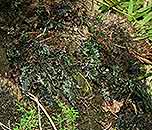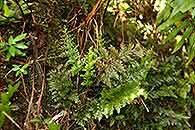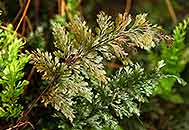Abrodictyum rigidum (Sw.) Ebihara & Dubuisson
Synonyms |
Trichomanes rigidum Sw. |
|---|---|
Common name |
|
Description |
Rhizome shortly creeping to suberect, c. 3 mm in diameter; rhizome scales covered with dark brown hairs. Fronds tufted, erect to pendant, dark green. Stipe up to 22 cm long, brown, narrowly winged near apex, glabrous or with sparse brown hairs to 1.5 mm long. Lamina 4-24 × 2-14 cm, 3-4 pinnatifid, narrowly ovate to lanceolate in outline, membranous but tough and leathery. Pinnae 14-20 on each side, shortly stalked, to 7 x 3 cm, uniformly developed; pinnules to 13 on each side, to 1.7 x 0.5 cm; ultimate lobes narrowly linear, to 0.3 mm wide, attenuate, glabrous on both surfaces. Rhachis narrowly winged in the upper part of the lamina. Sori c. 1.5 × 0.7 mm, narrowly conical, borne near the costules of the pinnules on the acroscopic side, not winged; indusium narrowly conical, 0.7-1.5 mm long, 0.5-0.7 mm in diameter, not winged, mouth dilated to 0.9 mm, valves entire; receptacles long, persistent, extruding beyond the sori valves. |
Notes | A. rigidum has a stiff, upright habit and finely divided fronds, this makes it easy to distinguish from other Hymenophyllaceae. |
Derivation | rigidum: rigid, stiff; the fronds of this species are erect and tough |
Habitat | Lithophytic in deeply shaded, continually moist boulders and earth-banks in evergreen forest, along streams and in the spray of or close to waterfalls and rapids. Always in very dark and continually wet areas. |
Distribution worldwide | Tropical and Southern Africa, also known from the Indian Ocean islands, South and Central America and the West Indies. |
Distribution in Africa |
Angola, Burundi, Cameroon, Central African Republic, Congo, Dem. Republic of Congo, Equatorial Guinea (incl. Bioko), Gabon, Ghana, Guinea, Ivory Coast, Kenya, Liberia, Malawi, Mozambique, Nigeria, Rwanda, Swaziland, Tanzania , Zambia, Zimbabwe. |
Growth form |
Lithophytic, terrestrial. |
Literature |
|



